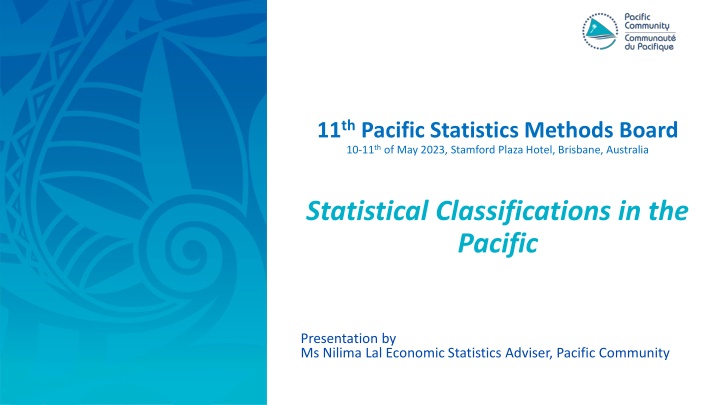
Pacific Harmonized Commodity Description and Coding System Overview
Explore the Pacific Harmonized Commodity Description and Coding System, a solution for Pacific nations to enhance international trade data comparability. This system expands categories from the Harmonized System, allowing for detailed regional goods identification. Learn about the classification structure and specific examples of regional sub-headings like Ginseng roots and Kava.
Download Presentation

Please find below an Image/Link to download the presentation.
The content on the website is provided AS IS for your information and personal use only. It may not be sold, licensed, or shared on other websites without obtaining consent from the author. If you encounter any issues during the download, it is possible that the publisher has removed the file from their server.
You are allowed to download the files provided on this website for personal or commercial use, subject to the condition that they are used lawfully. All files are the property of their respective owners.
The content on the website is provided AS IS for your information and personal use only. It may not be sold, licensed, or shared on other websites without obtaining consent from the author.
E N D
Presentation Transcript
11thPacific Statistics Methods Board 10-11thof May 2023, Stamford Plaza Hotel, Brisbane, Australia Statistical Classifications in the Pacific Presentation by Ms Nilima Lal Economic Statistics Adviser, Pacific Community
Pacific versions of international recommended Pacific versions of international recommended classifications classifications Pacific Harmonized Commodity Description and Coding System 2022 Pacific Classification of Individual Consumption According to Purpose Pacific Standard Classification of Occupations Pacific Standard Industrial Classification Link to the regional classifications page : https://sdd.spc.int/regional-classifications
Need for Pacific Versions Need for Pacific Versions PICTs have small national statistics offices Example: HS which is used for IMTS is updated every 5 years No of staff in 2019 Country NSO Issue Fig 1: HS Implementation by Members, 2017 American Samoa Cook Islands FSM Fiji Guam Kiribati RMI PNG Nauru Niue CNMI Samoa Tuvalu Vanuatu 7 When revised versions of international classifications are released NSOs (and Customs HS is used in IMTS) fail to adopt them: 12 10 21 10 10 146 30 14 8 6 5 4 4 5 Do not have the resources to nationalise their classification; some do not have the necessary skills to do it 3 134 2 1 5 4 6 0 HS 2017 HS 2012 HS 2007 HS 2002 No HS Australia and New Zealand are included in the 5 that adopted HS 17 in 2017 87 4 52
Solution: Pacific Harmonized Commodity Description and Coding System SPC-OCO-others collaborated for PACHS 17 then 22. WCO reviewed. Andrew Hancock, Chair UN expert group on classifications and UN Trade and Business Stats Division were consulted when needed. PACHS has been adopted from WCO s HS by expanding the categories of HS to take account of the international trade in goods in PICTs i.e. the most disaggregated category of HS, the HS subheading has been further disaggregated into Regional subheading to allow identification of regional goods internationally traded. As such PACHS can be easily converted to six- digit HS subheading. At this level the data are internationally comparable while at the regional sub-heading level the data are regionally comparable. Section Chapter HS HEADING HS SUB- HEADING REGIONAL SUB-HEADING SITC Rev 4 Basic Heading DESCRIPTION II VEGETABLE PRODUCTS 12 Oil seeds and oleaginous fruits; miscellaneous grains, seeds and fruit; industrial or medicinal plants; straw and fodder Plants and parts of plants (including seeds and fruits), of a kind used primarily in perfumery, in pharmacy or for insecticidal, fungicidal or similar purposes, fresh, chilled, frozen or dried, whether or not cut, crushed or powdered. -Ginseng roots 12.11 1211.20 1211.20.00 05896 1211.30 1211.30.00 -Coca leaf 292 1211.40 1211.40.00 -Poppy straw 292 1211.50 1211.50.00 -Ephedra 292 1211.60 1211.60.00 -Bark of African cherry (Prunus africana) 05896 1211.90 -Other: ---Piper methysticum (Kava): 1211.90.11 ----Piper methysticum (kava, yaqona or sakau) in dried chips form 05896 1211.90.12 ----Piper methysticum (kava, yaqona or sakau) in powder form 05896 1211.90.20 ---Noni (nonu) leaf 05896 1211.90.30 ---Sandalwood chips and shavings 05896 1211.90.90 ---Other 05896
Knowledge products Knowledge products Information paper The relevance of statistical classifications for Pacific Island countries and territories written by Mr Andrew Hancock of Stats NZ and Ms Nilima Lal of SPC. Reviewed by Mr Franklin Assoumou Ndong, Statistics Canada and Mr Vincent Russo, US Bureau of Labor Statistics. https://sdd.spc.int/digital_librar y/relevance-statistical- classifications-pacific-island- countries-and-territories 5
Result Result HS = PACHS UNCTAD is/will assist PICTs ASYCUDA World users use the 8-digit PACHS and nationalise their tariff codes at 10-digit e.g. Niue, FSM. Cook Islands used to use NZHS but are now using PACHS. ISCO = PACSCO Fiji used PACSCO for FISCO ISIC = PACSIC PNG used PACSIC for PNGSIC. Other countries are Vanuatu, American Samoa, Tonga COICOP = PACCOICOP Currently Fiji is using PACCOICOP for FCOICOP.
Conclusion Conclusion Deriving Pacific versions has helped countries use latest recommended classifications which is an important aspect of methodology. Some PICTs like to have national classifications which SPC has assisted PICTs with on a request basis. Having regional classifications allows PICTs to have their activities, occupations, goods and expenditure compared at the regional level at the international level
